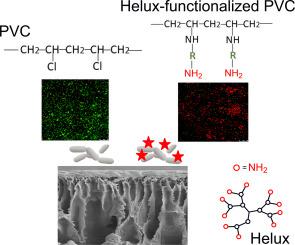Reactive & Functional Polymers ( IF 4.5 ) Pub Date : 2020-06-06 , DOI: 10.1016/j.reactfunctpolym.2020.104669 Berta Díez , Arcadio Sotto , Antonio Martín , Jesús Arsuaga , Roberto Rosal

|
Poly(vinyl chloride) (PVC) ultrafiltration membranes with improved antifouling and antibiofouling properties were prepared by non-solvent induced phase inversion using a hyperbranched polyamidoamine as additive. PVC reacted into the casting solution with the commercial polyamidoamine nanomaterial Helux-3316 by means of a nucleophilic substitution reaction. The composition of neat and functionalized membranes was studied by ATR-FTIR and elemental composition. Amino groups were tracked using the fluorescent dye fluorescamine. Surface ζ-potential and water contact angles were used to measure surface charge and hydrophilicity of tested membranes. The incorporation of amino groups increased membrane hydrophilicity and surface porosity, which resulted in enhanced permeability. Functionalized membranes displayed antifouling behaviour revealed upon filtering BSA solutions and lower irreversible fouling than PVC membranes. The attachment of Helux moieties to PVC yielded membranes with antibiofouling functionality explained by the interaction of positively charged Helux moieties with the negatively charged cell envelopes. Growth reduction for cells attached to the membrane surface during filtration reached up to 1-log for the Gram-positive bacterium S. aureus. This investigation revealed that the incorporation of the hyperbranched nanomaterial in concentrations in the order of 1 wt% in the casting solution provides significant benefits to membrane performance, in terms of permeability and antifouling potential.
中文翻译:

聚氯乙烯-超支化聚酰胺胺超滤膜,具有防污和防生物污染特性
使用超支化聚酰胺型胺作为添加剂,通过非溶剂诱导的相转化,制备了具有改进的防污和抗生物污垢性能的聚氯乙烯(PVC)超滤膜。PVC通过亲核取代反应与市售的聚酰胺胺纳米材料Helux-3316反应进入浇铸溶液中。通过ATR-FTIR和元素组成研究了纯净和功能化膜的组成。使用荧光染料荧光胺追踪氨基。表面ζ电势和水接触角用于测量被测膜的表面电荷和亲水性。氨基的引入增加了膜的亲水性和表面孔隙率,从而提高了渗透性。功能性膜在过滤BSA溶液时显示出防污性能,并且比PVC膜具有更低的不可逆结垢性。Helux部分与PVC的附着产生具有抗生物污损功能的膜,这可以通过带正电荷的Helux部分与带负电荷的细胞包膜的相互作用来解释。过滤过程中附着在膜表面的细胞的生长减少率达到革兰氏阳性细菌的1-log金黄色葡萄球菌。该研究表明,在流延溶液中以约1wt%的浓度掺入超支化纳米材料,就渗透性和防污潜力而言,对膜性能提供了显着的益处。









































 京公网安备 11010802027423号
京公网安备 11010802027423号